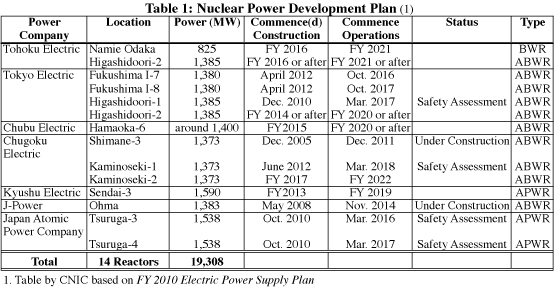2010 Fiscal Year Electric Supply Plan Nuke Info Tokyo No. 136
On March 31, the Ministry of Economy Trade and Industry’s Agency for Natural Resources and Energy released the 2010 Fiscal Year (FY2010) Electric Supply Plan Outline. The plan brings together the plans of all the electric power companies. Although it is referred to as a “plan”, as usual it has little relation to reality. Year after year the construction schedules for new nuclear reactors are postponed. This time the construction schedules of 8 of the 14 planned reactors have been pushed back.
For example, Tohoku Electric’s planned Namie Odaka plant is an 825MW BWR that was first included in the plan over 40 years ago. There is no chance that such an outdated reactor will be built, but each year the plan is religiously postponed for another year, without ever being removed from the list.

The government’s CO2 emissions reduction plan assumes that nine new reactors will be operating by FY2020. This is the same number of start-ups as is predicted in the Electric Supply Plan. However, considering the past record, basing the CO2 emissions reduction plan on the Electric Supply Plan is a recipe for failure. Construction of three of these nine reactors has been delayed repeatedly and there is considerable uncertainty about the other plans too. There have been reports that the government’s FY2030 CO2 emissions reduction targets will require fourteen new reactors, but given that these are the same fourteen reactors as those included in the Electric Supply Plan, relying on them to meet CO2 emissions reduction targets borders on the absurd.
The truth is that electric power companies don’t really want to build new nuclear power plants. An anonymous record of a round table discussion entitled “issues for the energy industry towards 2030” was published in the April 2010 edition of Energy Forum. An “electric power industry person” is reported to have made the following comment.
“Since demand won’t grow to match this much new capacity, presumably the financial situation of electric power companies will deteriorate. It is inconceivable that normal private companies would invest where they don’t anticipate demand, but the government’s CO2 emissions reduction target is premised on the construction of nine reactors. On this point, power companies cannot be like normal private companies.”
The facilitator, who was an “industry journalist”, showed sympathy saying, “Under the government’s 25% [CO2 emissions] reduction scenario, if power companies continue to make huge investments after constructing these nine reactors, they won’t survive without a considerable rise in electricity rates.”
The nuclear power burden
The Electric Power Supply Plan predicts that the average rate of growth in peak demand (kilowatts) over the next 10 years will be around 0.4%. This figure has fallen steadily from 0.9% in FY2007, 0.7% in FY2008, and 0.6% in FY2009. According to this estimate, while there will be progress in energy conservation, “stable growth is forecast against a backdrop of increased base demand associated with progress in the service economy and IT and expansion in the scale of the economy.”
Electric power companies decide to construct power stations in response to increased peak demand, so if they don’t predict an increase in peak demand, they want to postpone construction of new nuclear power plants.
What do electric power companies do when new nuclear power plants start operating? The answer is clearly shown in the supply-demand balance for each power company. Consider the case of Hokkaido Electric. Tomari-3 started commercial operations in December last year. At the time of FY2010 peak winter demand Hokkaido Electric’s surplus supply capacity was 25.4%. (In summer it was 37.2%.) Taking 8% to be a reasonable surplus, it is clear that Hokkaido Electric has excess capacity. Hence, it is predicting an increase in peak demand of 1.2% per annum – three times the national average – over the next 10 years. It is desperately promoting “all electric” housing. Even then, it still predicts that surplus supply capacity in FY2019 will be 11.3% in winter and 18.1% in summer.
In other words, power companies must either put even more effort into manufacturing demand for electricity, or they can try to sell their surplus to other power companies. However, since the other power companies predict lower growth in peak demand, Hokkaido Electric will struggle to sell its surplus to them.
Tomari-3 is a relatively small 912MW PWR. Nevertheless, bringing it online led to a capacity surplus. It is not hard to imagine the problem created by starting up a 1400MW ABWR, or a 1600MW APWR. On November 13, 1998, Takashi Furukawa, then Vice President of Chugoku Electric Power Company, bemoaned the predicament of electric power companies during a meeting of an expert committee established by the Electricity Industry Committee. He said, “We have to promote huge power plants at a time when demand for electricity is not increasing,”
Global Warming Deniers
Having to build nuclear power plants is a nuisance for electric power companies, but the reason why they are being asked to do so, namely demands for CO2emissions reductions, is an even bigger nuisance. Global warming deniers were fairly restrained in Japan until recently. However, since scandals involving the Intergovernmental Panel on Climate Change emerged, articles have appeared frequently in electricity industry magazines. The articles have a peculiar pro-nuclear twist, but they claim that energy conservation for the sake of CO2 emissions reductions is undesirable because it means falling demand for electricity. The focus, they say, should rather be on “energy security”.
Every nuclear accident is accompanied by a massive loss of electric power supply capacity. Hence, large-scale nuclear power plants actually threaten stable electricity supply. But the industry covers up the fragility of electricity supply systems that are highly dependent on nuclear power. Instead, it pushes the energy security argument by emphasizing the large output of nuclear power plants. On the surface it promotes nuclear power, but the real aim is to increase demand for electricity.
Baku Nishio (CNIC Co-Director)
